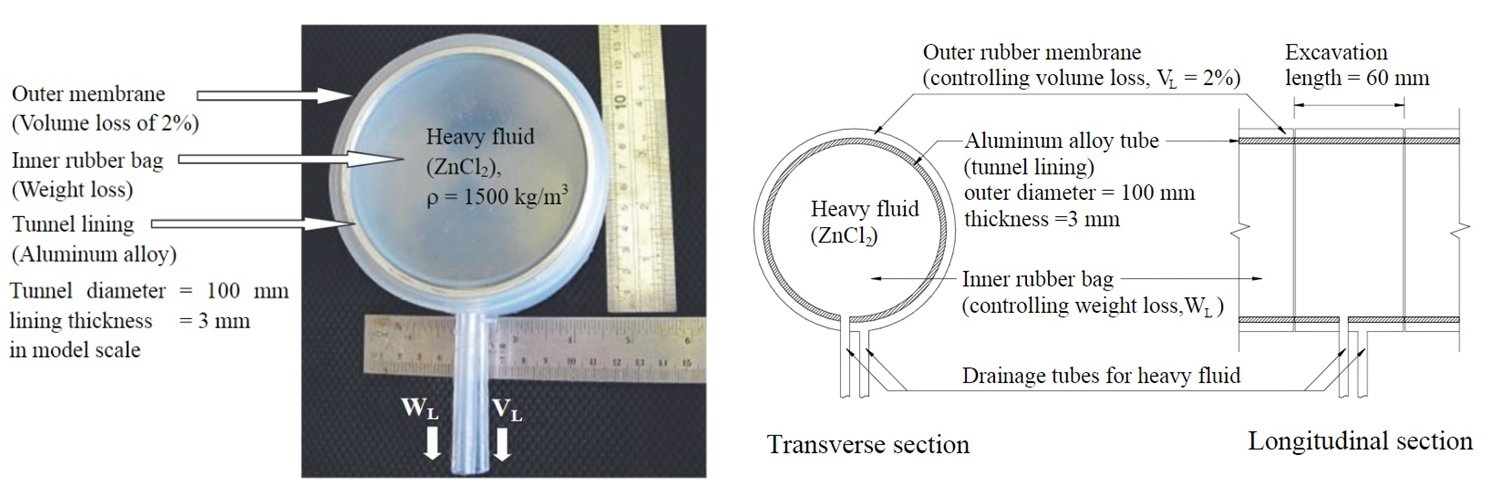Tunnelling simulation
A novel modeling device, which is called the “donut”, is developed to simulate the process of tunnel advancement in a centrifuge test. A pair of rubber bags, one mounted outside and the other mounted inside a model tunnel, can be used to simulate the effects of both volume and weight losses at each stage of excavation in the centrifuge.
During the centrifuge model preparation, each rubber bag was filled with a heavy fluid (ZnCl2) having a density similar to that of the soil sample to simulate the presence of soil. Each outer rubber bag was filled with a known amount of the heavy fluid representing an equivalent percentage of “volume loss”. Volume loss was simulated by controlling the outflow of the heavy fluid from the outer rubber bag. Likewise, each inner rubber bag was filled with the heavy fluid, which was drained away at different stages to simulate weight loss due to tunnel excavation in the centrifuge.
The new development has created various new avenues of research in soil-tunneling interaction:
- To investigate the influence of greenfield tunnel excavation on ground surface settlement and volume loss
- To study the response of existing tunnel due to new tunnel excavation (perpendicular, parallel, oblique)
- To investigate the response of existing structures (shallow and pile foundations, underground pipelines etc.) due to 3D excavation in stages and different sequence of tunnel excavation


Newly developed “donut” for simulating volume and weight losses simultaneously during tunnel advancement and tunnel advancing sequence in a centrifuge test
Journal Publications
- Ng, C. W. W., Boonyarak, T. & Masin, D. (2013). Three-dimensional centrifuge and numerical modelling of the interaction between perpendicularly crossing tunnels. Canadian Geotechnical Journal 50, No. 9, 935-946, https://doi.org/10.1139/cgj-2012-0445.
- Ng, C. W. W., Lu, H. & Peng, S. Y. (2013). Three-dimensional centrifuge modelling of twin tunnelling effects on an existing pile. Tunnelling and Underground Space Technology 35, 189-199, https://doi.org/10.1016/j.tust.2012.07.008.
- Ng, C. W. W. & Lu, H. (2014). Effects of the construction sequence of twin tunnels at different depths on an existing pile. Canadian Geotechnical Journal 51, No. 2, 173-183, https://doi.org/10.1139/cgj-2012-0452.
- Ng, C. W. W., Soomro, M. A. & Hong, Y. (2014). Three-dimensional centrifuge modelling of pile group responses to side-by-side twin tunnelling. Tunnelling and Underground Space Technology 43, 350-361, https://doi.org/10.1016/j.tust.2014.05.002.
- Boonyarak, T. & Ng, C. W. W. (2015). Effects of construction sequence and cover depth on crossing-tunnel interaction. Canadian Geotechnical Journal 52, No. 7, 851-867, https://doi.org/10.1139/cgj-2014-0235.
- Ng, C. W. W. Boonyarak, T. & Masin, D. (2015). Effects of pillar depth and shielding on the interaction of crossing multi-tunnels. Journal of Geotechnical and Geoenvironmental Engineering 141, No. 6, 04015021, https://doi.org/10.1061/(ASCE)GT.1943-5606.0001293.
- Ng, C. W. W., Hong, Y. & Soomro, M. A. (2015). Effects of piggyback twin tunnelling on a pile group: three-dimensional centrifuge and numerical modelling. Géotechnique 65, No. 1, 38-51, https://doi.org/10.1680/geot.14.P.105.
- Ng, C. W. W., Wang, R. & Boonyarak, T. (2016). A comparative study of different responses of circular and horseshoe-shaped tunnels to an advancing tunnel underneath. Géotechnique Letters 6, No. 2, 168–175, https://doi.org/10.1680/jgele.16.00001.
- Jiang, B., Chen, L., Yang, J. S., Wang, S. & Ng, C. W. W. (2017). Effects of twin tunnel excavation on an existing horseshoe-shaped tunnel with considering settlement joint. Canadian Geotechnical Journal 54, No. 9, 1346-1355, https://doi.org/10.1139/cgj-2015-0389.
- Soomro, M. A. & Ng, C. W. W. (2018). Lateral behaviour of a pile group due to side-by-side twin tunnelling in dry sand: 3D centrifuge tests and numerical modelling. Computers and Geotechnics 101, 48-64, https://doi.org/10.1016/j.compgeo.2018.04.010.
HKUST thesis
- Lu, H. (2013). Three-dimensional centrifuge and numerical modelling of twin tunnelling effects on piles. PhD thesis, Hong Kong University of Science and Technology.
- Soomro, M. A. (2013). Effects of advancing twin tunnels on pile group. PhD thesis, Hong Kong University of Science and Technology
- Boonyarak, T. (2014). Three-dimensional interaction of multiple crossing tunnels: centrifuge and numerical modeling. PhD thesis, Hong Kong University of Science and Technology.
- Chen, L. (2016). Effect of twin-tunnel excavation on existing horseshoe shaped tunnel. MPhil thesis, Hong Kong University of Science and Technology
- Wang, R. (2017). Effects of the existing tunnel shape on three-dimensional crossing tunnels interaction in sand: centrifuge and numerical modelling. MPhil thesis, Hong Kong University of Science and Technology.
- Wong, Y. Y. A. Influence of intersection angle of crossing tunnels on an existing tunnel. (ongoing research).